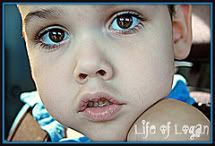By Martin F. Downs WebMD Feature and Reviewed by Louise Chang, MD.
All of this information can be found on the Web MD web site. You can got to their site by clicking here.
Sick days are part of being a kid; worrying about childhood illnesses is part of being a parent. You wonder, what's that weird rash? Does that cough sound worse than before? Am I going to catch this, too?
Parents quickly learn from experience all about ear infections, pinkeye, stomach bugs, colds, and the flu. These things may be most familiar to you, but there's a whole world of childhood illnesses out there that you may not know about. Let's get acquainted with some of these nasties now.
Six of these eight childhood illnesses are viral or bacterial infections. That means they are preventable to some extent by encouraging your child to keep his or her hands clean with old-fashioned soap and water. Practicing good "cough etiquette" is another important way of reducing the spread of childhood illnesses. Kids should be taught to cover their mouths when they cough and wash their hands afterward.
1. RSV
Respiratory syncytial virus (RSV) is a very common childhood illness. It's even more common than seasonal flu. "It causes a lot more problems for children than influenza does," says Michael Brady, MD, an infectious disease expert at Nationwide Children's Hospital, in Columbus, Ohio.
Most of us have had exposure to RSV (respiratory syncytial virus) by the time we're 2 years old. RSV causes some of the same symptoms as cold and flu, such as fever, runny nose, and cough.
For babies less than 1 year old, RSV is the most common cause of pneumonia and bronchiolitis, an inflammation of the small air passages in the lungs. Wheezing is a telltale symptom of these conditions, which sometimes have to be treated in the hospital. Only about 25% to 40% of young children with their first RSV infection will have any noticeable wheezing, however. Even fewer, 2% or less, are hospitalized.
RSV infections last about one to two weeks. You're not immune to RSV once you've had it. You can have an RSV infection at any age, but "after you get it a few times, it's just a cold to you," Brady says.
2. Fifth Disease
Fifth disease has been called the "slapped cheek" disease because it causes a red rash on the face that looks like a slap mark. A lacy red rash may also appear on the child's torso and limbs. Fifth disease doesn't always make a child feel ill, but it can feel like a cold early on, before the rash shows up.
The cryptic name is a holdover from medical lingo a century ago, when a French physician assigned numbers to the common childhood diseases characterized by rashes. For example, measles was "first disease," scarlet fever was "second disease," and so on.
We now know that fifth disease is caused by a virus called human parvovirus B19. Up to 20% of children may get the virus before age 5, and up to 60% have had it by age 19. Infections are usually not very serious and go away in seven to 10 days. Many children infected with the virus don't show any symptoms. "In most cases, it's a pretty benign situation," Brady says.
3. Hand, Foot, and Mouth Disease
Hand, foot, and mouth disease is not to be confused with foot-and-mouth disease, which infects only livestock. A common childhood illness, hand, foot, and mouth disease causes a fever with blisters or sores inside the mouth and on the palms and soles of the feet. The blisters may also appear on the buttocks, "but we decided to leave that out of the name," Brady says.
Hand, foot, and mouth disease is caused by a variety of viruses called enteroviruses. In the United States, the disease is usually caused by a virus known as coxsackievirus A16. This virus usually goes around in the summer and early fall.
Hand, foot, and mouth disease may cause a lot of discomfort, but for most children it isn't very serious and goes away on its own after a week to 10 days.
4. Croup
Croup is a childhood illness usually caused by a group of viruses called human parainfluenza viruses, which also cause the common cold. The main symptom of croup is a "barking" cough, sometimes likened to the barking sound a seal makes. Croup can be serious enough to require treatment in a hospital. Up to 6% of children with croup are hospitalized, but it is very rarely fatal. For severe cases, treatment helps to keep the sick child breathing normally until the infection ends. A case of croup typically lasts about one week.
It's estimated that six in 100 children get croup each year. Children who get it tend to be between 6 months and 12 years old, and it's seen most frequently in 2-year-old children.
5. Scarlet Fever
Scarlet fever is a rash that sometimes appears with strep throat -- an infection with a bacterium called group A streptococcus. A child with strep throat will usually have a very sore throat and high fever. The scarlet fever rash starts on the chest and abdomen and spreads all over the body. It is bright red like sunburn and feels rough like sandpaper. The color of the rash may be deeper around the armpits. The child's tongue may have a whitish appearance, except for the taste buds, which look bright red, a symptom known as "strawberry tongue." There may be some flushing in the face, with a paler area around the mouth.
Scarlet fever was once a feared and deadly childhood illness, but it is easily cured with antibiotics. Now scarlet fever is just another kind of rash.
6. Impetigo
Impetigo is a bacterial skin infection. It's the third most common skin condition in children, seen most often in children aged 2 to 6 years. It's very contagious, and adults can get it, too.
Impetigo appears on the skin as clusters of itchy little bumps or sores that weep fluid, forming a honey-colored crust over them. Touching the fluid from the sores can spread an impetigo infection to the skin on different parts of the child's body, as well as to other people.
Prescription antibiotics are needed to clear up an impetigo infection. The sores heal without causing scars.
7. Kawasaki Disease
Kawasaki disease is a very rare childhood illness with no known cause. It is a peculiar combination of symptoms including a high fever, rash, red palms and soles of the feet, swollen hands and feet, bloodshot eyes, swollen lymph glands, and chapped lips. The disease can cause the vessels of the heart to become inflamed, damaging the heart. In the hospital, doctors treat Kawasaki disease with high doses of drugs that boost the body's immune response. Most children recover with treatment, but the disease is sometimes fatal.
A doctor named Tomisaku Kawasaki first discovered the disease in Japan in the 1960s. It's still most common in Japan, but each year in the U.S., hospitals admit about 4,000 children suffering from Kawasaki disease. Most of them are children younger than age 5.
Whatever makes these children sick has eluded researchers for decades. But an idea that has some traction among scientists, Brady says, is that an infection, maybe a virus, triggers this reaction in children who have a certain genetic trait.
8. Reye's Syndrome
Reye's syndrome is a very serious but now extremely rare childhood illness. If you've ever wondered why you shouldn't give aspirin to children, Reye's is the reason. Reye's syndrome comes on suddenly after a viral illness like chickenpox or the flu. It causes liver problems and brain swelling, leading to radical behavior and personality changes, loss of conscious, seizures, and coma. About 30% of children who have fallen ill with Reye's syndrome die from it.
The cause of Reye's syndrome is still unknown, but there's a lot of evidence to suggest that it's somehow related to taking aspirin during a viral illness.
The CDC first warned about the possible link between aspirin and Reye's syndrome in 1980. Afterward, the number of cases reported each year fell sharply, from 555 cases reported in 1980, to no more than two per year between 1994 and 1997. "It really isn't something we see more than once every 10 years now," Brady tells WebMD.
Since my blog is about raising children with rare childhood diseases and disorders I really thought this story is quite fitting. I do know that Autism is not as rare as many people seem to think it is, actually it's statistics are quit staggering. Hopefully next weekend I can post more on that subject. And please for any of you out there that are reading this I do not want you to think I am expert on any of this for I am not. Alot of what I do know I have learned through personal experience. Such as the fact that I had never heard of Riley-Day syndrome until my own child was diagnosed with it in November 2009. That disorder/disease is so rare it only affects 1 in every 3,700 people.












I have had a student experience all but Reye's syndrome in my 34 years in the classroom. I think this was a great post for you to share with parents!!!!!
ReplyDelete